How to Grow Hollyhocks (Alcea) in Your Flower Garden
Updated: Apr. 10, 2024
Hollyhocks are old-fashioned flowers, typical of the "cottage garden" style. Known for their height, hollyhocks create walls of color.
On This Page
Growing Tips for Hollyhocks
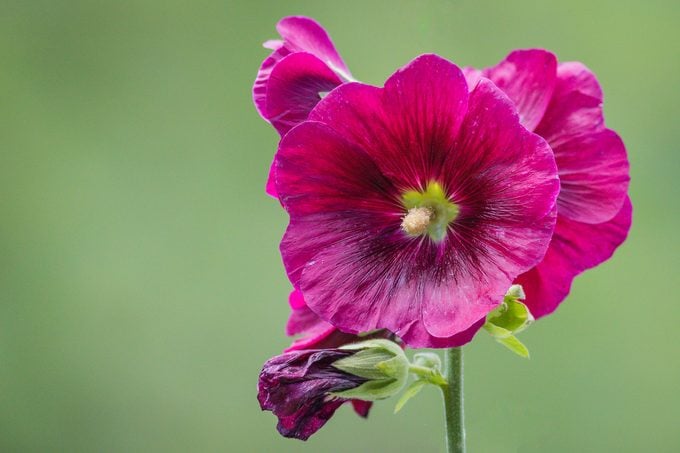
- Common name: Hollyhocks
- Scientific name: Alcea spp.
- Zones: Zone 3 to 10 or Annual (some varieties are hardy to Zone 2)
- Light: Full sun
- Water: Moderate and drought tolerant when established
- Preferred soil: Rich, well-draining
- Mature Size: 4 to 8 feet tall and 1 to 2 feet wide
- Attracts: bees, butterflies, hummingbirds, birds
Hollyhocks are old-fashioned, summer-flowering plants, typical of the “cottage garden” style. Flowers open at the base of the flower stalk and continue up, remaining open for several days. Tall spires—4 to 6 feet tall—of many blossoms make it look like the entire plant blooms for months.
“I’m a huge hollyhock fan!” says author and horticulturalist Joseph Tychonievich. “They’re so easy to grow from seed, which makes them a very affordable way to fill up a garden, and the flowers are always a huge hit with bees and other pollinators.”
Are Hollyhocks Annuals or Perennials?
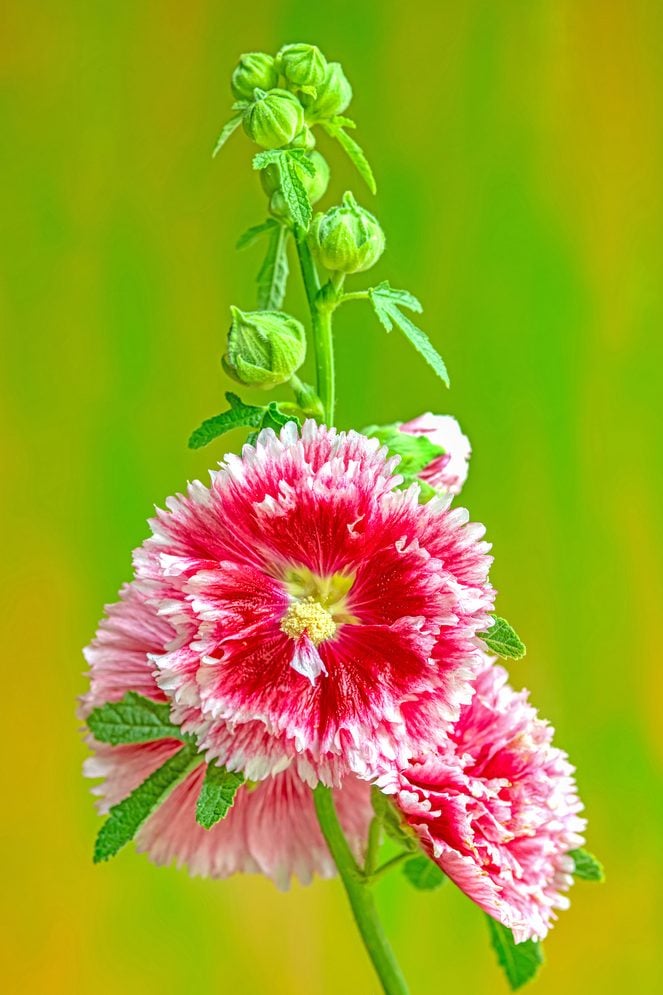
Most plants we grow are hybrids of Alcea rosea, which are short lived perennials or biennials. Biennial plants produce foliage in the first year; flower and set seed in the second year. These plants readily self-seed, so they appear to be perennials because new plants grow each year.
There are also dwarf forms, which bloom in the first year and are treated like annuals. A few species are true perennials.
When and Where to Plant Hollyhocks
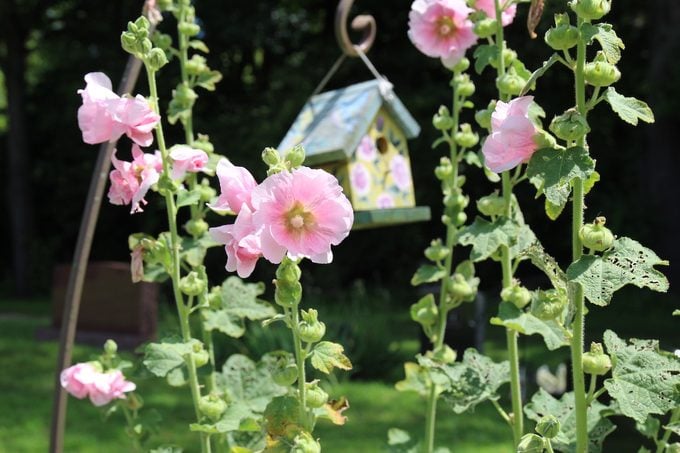
Direct sow seeds outdoors in the beginning of summer or a few weeks after the average last frost. In a full sun area with well drained soil high in organic matter, press a few seeds on moist soil, about 2 feet apart. As they grow, thin the seedlings to have one plant per 2 feet. Usually, the plants do not need staking. They look especially attractive when planted in groups at the back of the perennial border, or along walls or fences.
The blossoms do not need to be deadheaded but the flower stalk can be removed once all flowers have bloomed. The plants should be fertilized in the beginning of the growing season but not during the summer.
Each year, after autumn’s first frost, gardeners should cut the growth down to the ground, bag, and throw it away. Bagging instead of putting plant material in the compost pile reduces the risk of fungal spores overwintering in the garden.
Do Hollyhocks Attract Pollinators?
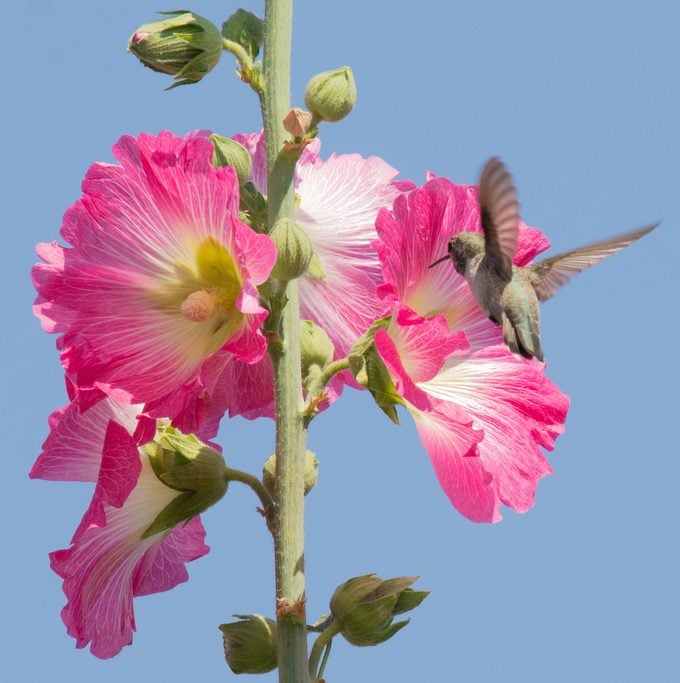
Flowers attract bees, butterflies, and hummingbirds. Birds eat the seed and deer are not interested in these plants.
Pests and Diseases
Rust is a common fungal disease especially in hot, humid places. Rust initially appears as orange and yellow spots on the top of the lower leaves. As the disease progresses, brown to red raised bumps appear on the leaves’ undersides. This is unsightly and can stunt growth but usually does not kill the plant. However, rust can spread to other hollyhock plants and other members of the mallow family—other non-related plants are not susceptible to this strain of rust.
“The one downside, in my experience, is rust,” says Joseph. “Unfortunately, every species I’ve tried, even those marketed as rust resistant, do get rust. My solution is just to grow them in the back of a bed with other plants in front of them to hide the rust.”
To help prevent fungal diseases, use good gardening practices such as adequate spacing, good air circulation, not watering overhead or in the evening, and removing infected leaves immediately. The performance of rust-resistant varieties depends on the local environment. There are preventive fungicides that you can try, but once the rust appears, fungicide will not eradicate the infection.
The plants also attract a variety of “foliage eaters,” including Japanese beetles, weevils, and sawflies. All three will feed on the foliage but can be picked off by hand and dumped into a bucket of soapy water.
Varieties of Hollyhocks to Grow
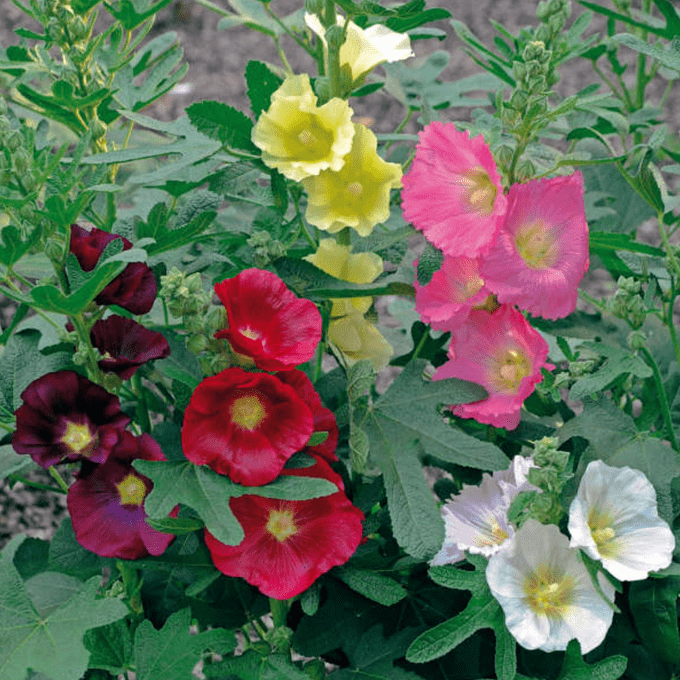
Flower colors range from red, pink, purple, yellow, and white to “black” (dark purple) in single or double flowered forms. The most common strain was developed by English horticulturist William Chater in the 1800s. Chater’s are double flowered in a range of colors. These are biennials or short-lived perennials.
Jelitto Perennial Seeds breeders developed the single-bloomed, Spotlight series: Blacknight (appears black but is dark purple); Mars Magic (bright red); Polarstar (white with a yellow eye); and Sunshine (bright yellow).
Thompson & Morgan created the Halo series which has large, single flowers and contrasting centers in a variety of colors. Both series are perennials that will flower in the first year.
Two species touted as rust resistant are fig-leaf (A. ficifolia) and Russian (A. rugosa). Fig-leaf has been bred with A. rosea to produce a wider color range; however, those plants may not be as rust resistant as the species. Still, consider growing Happy Lights (yellow, red, purple, salmon) and Las Vegas (brown to red, pink to white and yellow to copper). The Russian hollyhock produces only yellow flowers.
Dwarf forms, reaching 2 to 3 feet tall, have double flowers and include the Queeny series, the Spring Celebrities Mix, and the Majorette Mix.
Sources
- University of Wisconsin-Madison Division of Extension — hollyhock rust
- Purdue University Landscape Report – jolly hollyhock rust
- North Carolina Cooperative Extension
- Iowa State University Extension
- University of Arkansas Cooperative Extension Service – hollyhock
- Greenhouse Product News
- Walters Gardens
- Perennialresource.com
About the Expert
Joseph Tychonievich is a horticulturist, speaker, plant breeder, and author of Plant Breeding for the Home Gardener (in which he talks about hollyhocks), Rock Gardening: Reimagining a Classic Style, and most recently The Comic Book Guide to Growing Food.
Why Trust Us
For nearly 30 years, Birds & Blooms, a Trusted Media Brand, has been inspiring readers to have a lifelong love of birding, gardening and nature. We are the #1 bird and garden magazine in North America and a trusted online resource for over 15 million outdoor enthusiasts annually. Our library of thousands of informative articles and how-tos has been written by trusted journalists and fact-checked by bird and garden experts for accuracy. In addition to our staff of experienced gardeners and bird-watchers, we hire individuals who have years of education and hands-on experience with birding, bird feeding, gardening, butterflies, bugs and more. Learn more about Birds & Blooms, our field editor program, and our submission guidelines.





















